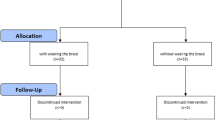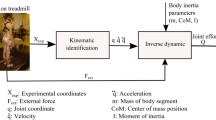Abstract
Purpose
Adolescent idiopathic scoliotic (AIS) deformity induces excessive oxygen consumption correlated to a bilateral increase of lumbo-pelvic muscles timing activity (EMG) during gait. Wearing a brace, the usual treatment for AIS, by supporting the spine and the pelvis, would generate lumbo-pelvic muscular relaxation and consequently reduce excessive oxygen consumption. The purpose of this study was to evaluate the short-term effect of bracing on gait biomechanics in scoliotic spine when compared with normal braced spine.
Methods
Thirteen healthy volunteers were compared to 13 AIS girls. In both samples, gait analysis was assessed using a three-dimensional motion analysis, including synchronous kinematic, electromyographic, mechanical and energy measurements, first without brace, then wearing a brace.
Results
For scoliotic patients, comparison of in-brace and out-brace situations revealed a significant decrease of frontal pelvis (p < 0.001), hip (p < 0.001) and shoulder (p = 0.004) motion in brace associated with a significant reduction of pelvis rotation (p = 0.003). However, the brace did not change significantly the lumbo-pelvic muscle activity duration (EMG) or the mechanical and energetic parameters. Transversal pelvis motion was reduced by 39 % (p = 0.04), frontal hip and shoulder motions by 23 % (p = 0.004) and 30 % (p = 0.01) respectively, and energy cost of walking remained increased by 37 % in braced AIS girls relatively to braced healthy subjects. Mechanical and electromyographic variables were not significantly different between the two braced populations during gait except for the gluteus medius muscle that showed bilaterally an increase of duration of electrical activity in healthy subjects and contrarily a decrease in AIS patients (healthy: −3.5 ± 9.6 % of gait cycle vs. scoliotic: 3.7 ± 7.7 % of gait cycle; p = 0.04).
Conclusions
Bracing changed neither the oxygen consumption nor the timing of the lumbo-pelvic muscles activity in both groups during gait. However, in brace the timing activity of bilateral gluteus medius muscles tended to decrease in AIS patients and increase in healthy subjects. Moreover, braced AIS patients had more restricted frontal hips and shoulder motion as well as pelvis rotation than braced healthy subjects.

Similar content being viewed by others
References
Brox JI, Lange JE, Gunderson RB, Steen H (2012) Good brace compliance reduced curve progression and surgical rates in patients with idiopathic scoliosis. Eur Spine J 21:1957–1963
Cavagna GA (1975) Force platforms as ergometers. J Appl Physiol 39:174–179
Cavagna GA, Kaneko M (1977) Mechanical work and efficiency in level walking and running. J Physiol 268:467–481
Chase AP, Bader DL, Houghton GR (1989) The biomechanical effectiveness of the Boston brace in the management of adolescent idiopathic scoliosis. Spine 14:636–642
Cobb J (1948) Outline for study of scoliosis. Am Acad Orthop Surg 5:261–275
Dierick F, Aveniere T, Cossement M, Poilvache P, Lobet S, Detrembleur C (2004) Outcome assessment in osteoarthritic patients undergoing total knee arthroplasty. Acta Orthop Belg 70:38–45
Guo J, Liu Z, Lv F, Zhu Z, Qian B, Zhang X, Lin X, Sun X, Qiu Y (2012) Pelvic tilt and trunk inclination: new predictive factors in curve progression during the Milwaukee bracing for adolescent idiopathic scoliosis. Eur Spine J 21:2050–2058
Kerrigan DC, Viramontes BE, Corcoran PJ, LaRaia PJ (1995) Measured versus predicted vertical displacement of the sacrum during gait as a tool to measure biomechanical gait performance. Am J Phys Med Rehabil 74:3–8
Kling TF Jr, Drennan JC, Gryboski JD (1981) Esophagitis complicating scoliosis management with the Boston thoracolumbosacral orthosis. Clin Orthop Relat Res 159:208–210
Korovessis P, Kyrkos C, Piperos G, Soucacos PN (2000) Effects of thoracolumbosacral orthosis on spinal deformities, trunk asymmetry, and frontal lower rib cage in adolescent idiopathic scoliosis. Spine 25:2064–2071
Kramers-de Quervain IA, Muller R, Stacoff A, Grob D, Stussi E (2004) Gait analysis in patients with idiopathic scoliosis. Eur Spine J 13:449–456
Labelle H, Bellefleur C, Joncas J, Aubin CE, Cheriet F (2007) Preliminary evaluation of a computer-assisted tool for the design and adjustment of braces in idiopathic scoliosis: a prospective and randomized study. Spine (Phila Pa 1976) 32:835–843
Labelle H, Dansereau J, Bellefleur C, Poitras B (1996) Three-dimensional effect of the Boston brace on the thoracic spine and rib cage. Spine 21:59–64
Lenke LG, Betz RR, Harms J, Bridwell KH, Clements DH, Lowe TG, Blanke K (2001) Adolescent idiopathic scoliosis: a new classification to determine extent of spinal arthrodesis. J Bone Joint Surg Am 83-A:1169–1181
Lenke LG, Engsberg JR, Ross SA, Reitenbach A, Blanke K, Bridwell KH (2001) Prospective dynamic functional evaluation of gait and spinal balance following spinal fusion in adolescent idiopathic scoliosis. Spine 26:E330–E337
Lindh M (1978) Energy expenditure during walking in patients with scoliosis. The effect of the Milwaukee brace. Spine 3:313–318
Mahaudens P, Banse X, Detrembleur C (2008) Effects of short-term brace wearing on the pendulum-like mechanism of walking in healthy subjects. Gait Posture 28:703–707
Mahaudens P, Banse X, Mousny M, Detrembleur C (2009) Gait in adolescent idiopathic scoliosis: kinematics and electromyographic analysis. Eur Spine J 18:512–521
Mahaudens P, Detrembleur C, Mousny M, Banse X (2009) Gait in adolescent idiopathic scoliosis: energy cost analysis. Eur Spine J 18:1160–1168
Massaad F, Lejeune TM, Detrembleur C (2007) The up and down bobbing of human walking: a compromise between muscle work and efficiency. J Physiol 582:789–799
Muller C, Fuchs K, Winter C, Rosenbaum D, Schmidt C, Bullmann V, Schulte TL (2011) Prospective evaluation of physical activity in patients with idiopathic scoliosis or kyphosis receiving brace treatment. Eur Spine J 20:1127–1136
Odermatt D, Mathieu PA, Beausejour M, Labelle H, Aubin CE (2003) Electromyography of scoliotic patients treated with a brace. J Orthop Res 21:931–936
Perdriolle R, Vidal J (1985) Thoracic idiopathic scoliosis curve evolution and prognosis. Spine 10:785–791
Richards BS, Bernstein RM, D’Amato CR, Thompson GH (2005) Standardization of criteria for adolescent idiopathic scoliosis brace studies: SRS Committee on Bracing and Nonoperative Management. Spine 30:2068–2075 (discussion 2076–2077)
Roche AF, Eyman SL, Davila GH (1971) Skeletal age prediction. J Pediatr 78:997–1003
Schmitz A, Konig R, Kandyba J, Pennekamp P, Schmitt O, Jaeger UE (2005) Visualisation of the brace effect on the spinal profile in idiopathic scoliosis. Eur Spine J 14:138–143
Stoquart G, Detrembleur C, Lejeune T (2008) Effect of speed on kinematic, kinetic, electromyographic and energetic reference values during treadmill walking. Neurophysiol Clin 38:105–116
Tesio L, Civaschi P, Tessari L (1985) Motion of the center of gravity of the body in clinical evaluation of gait. Am J Phys Med 64:57–70
Van Boxtel GJ, Van den Berg Lenssen MM, Brunia CH (1993) Detection of EMG onset in ERP research. Psychophysiology 30:405–412
van Poppel MN, de Looze MP, Koes BW, Smid T, Bouter LM (2000) Mechanisms of action of lumbar supports: a systematic review. Spine 25:2103–2113
Waters RL, Campbell J, Thomas L, Hugos L, Davis P (1982) Energy costs of walking in lower-extremity plaster casts. J Bone Joint Surg Am 64:896–899
Waters RL, Mulroy S (1999) The energy expenditure of normal and pathologic gait. Gait Posture 9:207–231
Willems PA, Cavagna GA, Heglund NC (1995) External, internal and total work in human locomotion. J Exp Biol 198:379–393
Wong MS, Cheng CY, Ng BK, Lam TP, Sin SW, Lee-Shum LF, Chow HK, Tam YP (2008) The effect of rigid versus flexible spinal orthosis on the gait pattern of patients with adolescent idiopathic scoliosis. Gait Posture 27:189–195
Zheng X, Sun X, Qian B, Wu T, Mao S, Zhu Z, Wang B, Qiu Y (2012) Evolution of the curve patterns during brace treatment for adolescent idiopathic scoliosis. Eur Spine J 21:1157–1164
Conflict of interest
None.
Author information
Authors and Affiliations
Corresponding author
Rights and permissions
About this article
Cite this article
Mahaudens, P., Banse, X., Mousny, M. et al. Very short-term effect of brace wearing on gait in adolescent idiopathic scoliosis girls. Eur Spine J 22, 2399–2406 (2013). https://doi.org/10.1007/s00586-013-2837-y
Received:
Revised:
Accepted:
Published:
Issue Date:
DOI: https://doi.org/10.1007/s00586-013-2837-y




